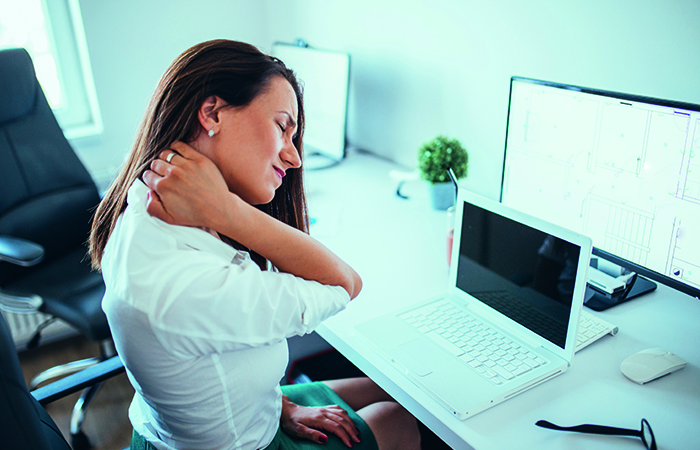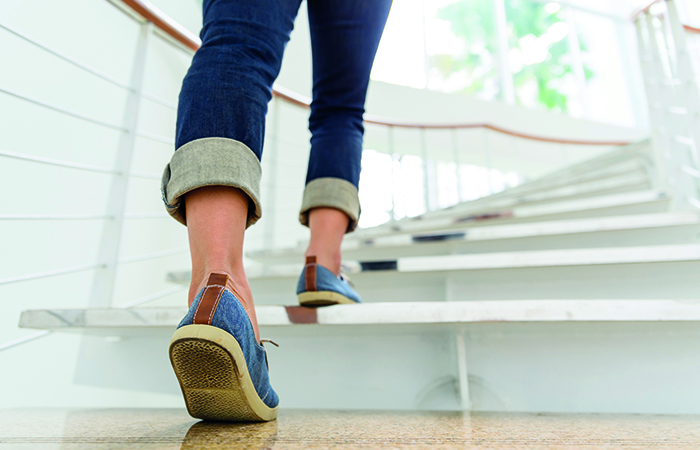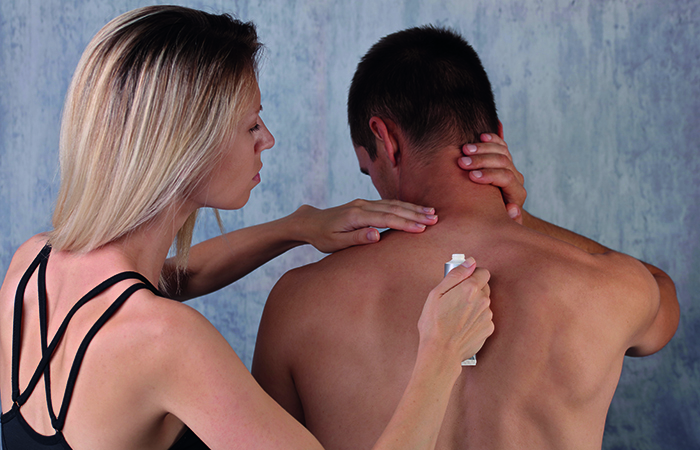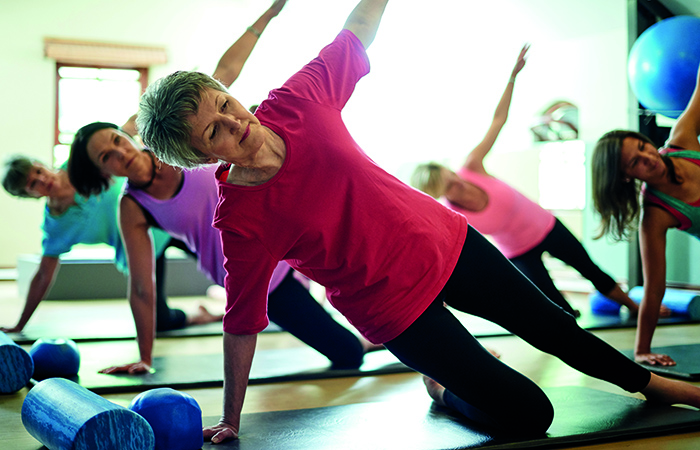The painful truth
In OTC
Follow this topic
Bookmark
Record learning outcomes
Grumbling about our aches and pains is a British trope, but our chair-bound lifestyles are creating an epidemic of pain that is sweeping the nation. What can pharmacy teams do to help?
Whether we’re curled up on the sofa engrossed in Netflix or spending nine hours a day in an office chair, as a nation we’re sitting more and moving less. And with sedentary lifestyles becoming the norm, bad posture and head, neck and upper back pain are too.

While muscular aches and pains are often regarded as problems that come with old age, new research for pharmaceutical aromatherapy brand Puressentiel confirms that muscular problems begin much earlier than many of us might imagine. The research shows that one in three (32 per cent) 18- to 24-year olds noticed an increase in aches and pains in the past year, and almost one in 10 (nine per cent) reported a significant deterioration.
Poor posture and pain
According to the Office for National Statistics (ONS), musculoskeletal problems including back pain, neck and upper limb problems resulted in 30.8 million sick days in the UK last year, equal to 22.4 per cent of all absences. But how do bad posture and sedentary lifestyles cause different types of body pain? GP Dr Roger Henderson has written extensively on the subject of pain and pain management, and works in his practice to audit analgesia prescribing and prevent inappropriate long-term prescribing.
He says poor posture typically occurs when the spine is positioned in an anatomically unnatural position: “This results in the joints, muscles and vertebrae coming under stress and leads to a build-up of pressure on these areas. Lower back pain is the most frequent problem here but neck, shoulder and arm pain is also common as a result of poor posture. Lower limb pain including leg and hip, knee or ankle pain may occur, and tension headaches are common due to muscle tension in the upper back, neck and shoulders.”
A sedentary lifestyle will also make it more likely that musculoskeletal pains will happen, according to Dr Jonathan McGhie, board member of the Faculty of Pain Medicine – part of the Royal College of Anaesthetists. He says this is because “the necessary muscle flexibility and strength will have been lost from inactivity. Over-straining will occur at a lower threshold as joints will be stiff, and in addition, cardiovascular fitness will be reduced and stamina impaired, reducing the ability to undertake exercise or activity.”
However, Dr Paul Cameron, national lead clinician (acting), Scottish Government and NHS Fife, says that bad posture and sedentary lifestyles are not, in themselves, causative of different body pains. “Rather, they tend to contribute to already existing pain that may have a different origin”, he says, “[and] it is known that pain that is exacerbated by poor postural positions.

Daily impact
What we also know is that living with pain can have a detrimental effect on people’s quality of life.
Acute pain can be severe but is usually short-lived and full recovery will occur following a period of rest and rehabilitation. “However,” says Dr McGhie, “when pain goes beyond the normal healing time and becomes chronic then it often has a profound, negative impact on the individual’s life, especially as the pain can persist for years, even after the original injury has healed.”
And this impact isn’t just physical. Peter Moore, developer of the Pain Toolkit, which helps people all over the world self manage persistent pain, says common problems that people living with persistent pain can experience include: creating no-go lists of things they cannot do; weight loss or gain; sleep problems, tiredness and fatigue; stress; fear; anxiety; anger and frustration; depression; and mood swings.
In fact, a recent survey by pain relief brand Solpadeine found that nearly two in fi ve people (37 per cent) have felt depressed as a result of their moderate pain, and it has led to a loss or decline in mobility for more than a quarter (29 per cent) of people.
Emma Davies, advanced pharmacy practitioner in pain management at Abertawe Bro Morgannwg University Health Board in Wales and chair of the Primary Care Pharmacy Association Pain Group, says another knock-on effect of longterm pain can be ”debilitating social and mental isolation”. However, by understanding what is going on, staying active and taking advice on medicines, she says ”people can live very well, even whilst experiencing some pain”.
Medicines options
Oral painkillers are one of the first choices for managing and preventing pain, making community pharmacy a regular starting point for pain sufferers.
Customers with acute pain can start by taking paracetamol or ibuprofen, but if the pain persists they may need to step up to a combination treatment such as paracetamol and codeine. However, these should not be taken for more than a few days, and if their pain persists beyond this, they should see their GP.
On the other hand, clinical physiotherapist and adviser to Puressentiel, Dan Jones, says oral analgesics should not necessarily be the first option for muscular pain and long-term use can be problematic.
He explains: “It is easy to reach for oral painkillers but they can cause problems. Paracetamol is the most common cause of liver failure in the developed world and it has also been linked to a 68 per cent increase in heart attack risk. Non-steroidal antiinfl ammatory drugs (NSAIDs), including aspirin and ibuprofen, often cause gastric side effects and researchers at Oxford University have estimated that every year, 2,600 people die as a result of gastric bleeds caused by these medicines. And last year, research from the Karolinska Institute in Sweden showed that using NSAIDs for as little as eight weeks inhibits muscle growth in healthy, young adults.”

Topical pain relief
An alternative option is topical pain relief, although these products are not suitable for all types of pain, or for all patients.
“Topical anti-inflammatory creams, often used when a patient is unable to tolerate oral anti-inflammatories, can be useful in musculoskeletal or arthritic pain,” says Dr Cameron, “and capsaicin topical cream (0.025 per cent or 0.075 per cent), only available on prescription, can be useful for painful sensitivity caused by manifestations like neuropathic pain. Other creams, such as lidocaine cream, also exist to provide instant relief through localised anaesthetisation for skin sensitive pain.”
Jillian Watt, director at Mentholatum and a qualified pilates teacher, says topical products can be a useful suggestion for older customers and anyone already taking multiple medications, or those who are unwilling or unable to take pills and tablets.
She says: “For suitable patients, topical analgesics have a number of advantages: they deliver targeted, effective relief at the point of pain; because they do not enter the bloodstream they do not pass through the internal organs and may be associated with fewer gastric side effects; and there are many drug-free options on the topical fixture, ideal for patients who are concerned about taking drug-based medication.
“However, because of the wide choice, customers may need guidance in choosing the most appropriate product for their particular needs, so pharmacy staff need to be confident about which product to recommend for different types of pain. For example, stiff, aching muscles may benefit from a heat product, while sharp, shooting pains and sprains and strains are best treated in the first 72 hours with cold therapy and inflammatory pain can be relieved by topical NSAIDs.”
A new generation of ibuprofen
A new form of ibuprofen is now available from pharmacy for the relief of rheumatic or muscular pain, back pain, and the pain of non-serious arthritic conditions, caused by swelling, stiffness and inflammation.
Flarin 200mg soft capsules contains OTC lipid-formulation ibuprofen that is clinically proven to be as effective as prescription-strength ibuprofen, according to manufacturer Infirst Healthcare. Flarin encases ibuprofen in lipids. This helps it to travel through the stomach and into the small intestine where the lipids are broken down, allowing the ibuprofen to be absorbed and transported around the body to the sites of pain and inflammation.
A double-blind, randomised, multicentre study looking at episodic knee pain and published in the journal Osteoarthritis and Cartilage, demonstrated that combining ibuprofen in a lipid formulation can deliver effective flare-up control.
Running hot and cold
Hot and cold therapy is another way to help manage pain symptoms. As a general rule of thumb, use ice for acute injuries or pain, along with inflammation and swelling, and use heat for muscle pain or stiffness.
“Heat therapy works by improving circulation and blood flow to a painful area due to increased temperature,” explains Dan. “Increasing the temperature of the afflicted area can soothe discomfort and increase muscle flexibility, relax and soothe muscles and heal damaged tissue.”
“Cold therapy works by reducing blood flow to a particular area,” explains Dr Henderson, “which can reduce inflammation and swelling that causes pain, especially around a joint or a tendon. It can temporarily reduce nerve activity, which can also relieve pain.”
There are caveats to use. “To relieve initial pain it could be useful to apply ice packs wrapped in damp towels for five minutes every hour for the first one or two days,” says Dr Cameron, “but always make sure you have a cloth between your skin and the ice to prevent an ice burn, and never lay on an ice pack.”
As temperature sensation is carried by the same fibres that transmit pain, Dr McGhie warns that: “In neuropathic pain conditions patients will comment on altered temperature sensations and will often have a reduced tolerance for one or both types of temperature in the affected area. Topical therapies that cool or heat should therefore be avoided if patients have reduced sensation, to reduce the risk of skin damage or burn.”
Self care measures
As with so many conditions, self care measures also have a role to play. ”Self care is vital for effective pain management, whether in the short or long term,” says Emma, ”so it would be great if self care advice was provided with every sale of an analgesic product.”
Many people get stuck in a pain cycle and a way to break out of it is to attend a pain management programme, such as those listed by the British Pain Society. However, Peter points out that pain affects people in different ways: “While one self-management plan may help one person, that same plan may not be useful for another.”
Dr McGhie recommends massage: “In pain physiology, the gate theory of pain has shown that by stimulating larger fibre nerves – for example, by rubbing adjacent tissue to the injury – it is possible to reduce the transmission of pain signals.” Dan is also a proponent of massage, coupled with essential oils, which he says are “proven ways to help relieve pain because they both work to increase blood flow and relax muscle tissue and there is likely a synergistic effect, which amplifies this effect.”
Dr Henderson’s advice is to try not to focus on the pain: “Concentrate on other things so the pain isn’t the only thing on your mind. When in pain, focus on breathing correctly. Shallow rapid breathing can make you feel dizzy, anxious or panicked, so instead, breathe slowly and deeply, as this will help you to feel more in control of the situation, keep you relaxed and prevent any muscle tension or anxiety from worsening your pain.”
Dr McGhie also suggests therapies which promote calmness, a positive mental attitude and relaxation “will all have a positive impact on pain – mindfulness and yoga-style techniques can help”. Dr Henderson adds that pharmacy teams can “direct your customer to ask their GP about these in the first instance, as there may be classes available locally or at a local pain clinic”.
Improve posture, minimise pain

Poor posture contributes to repetitive body strains, which may lead to more widespread and persistent muscle and joint pains. Identifying and correcting small postural issues in daily life will reduce the build-up of strains and muscle tension.
- Whilst sitting, keep your head, shoulders and spine in a vertical line
- When lifting, keep your back straight and use your strongest muscles and joints in your legs rather than bending your back to pick something up
- At work, adjust your chair and desk height so that your thighs and forearms are parallel to the ground while you are sitting. To protect your neck and shoulders, your computer screen should ideally be at eye level
- Taking breaks for short walks, gentle stretches or regular changes in position will also reduce the impact of poor posture
- At rest, make sure your pillow supports your head properly when you sleep, and consider how supportive your sofa is
- Regular stretching or activities like yoga, pilates and tai chi are helpful to strengthen and lengthen muscles and may contribute to improved posture.
The role of exercise
A recent series of papers in The Lancet claimed that while lower back pain is the leading cause of disability globally, patients are let down by the treatment they are offered. They said that there is limited evidence that strong drugs, injections and surgery help, and advised that most back pain is best managed by keeping active.
Dan says that it’s the little changes that can be easily incorporated into everyday life that will help reduce the risk of muscular injury: “Walk over to a colleague rather than send an email, get off the bus a stop earlier or take the stairs instead of the lift.”
Dr Henderson says staying active also helps lessen pain “by stretching stiff and tense muscles, ligaments and joints”. Dr McGhie adds that: “Exercise stimulates the body’s natural painkillers – endorphins – to create the feeling of achievement and vitality. Participation in team sports will also help mental and social functioning.”
However, excessive, strenuous or poorly performed exercise can lead to musculoskeletal injury, so Emma stresses that exercise doesn’t have to mean running a marathon or going to the gym: ”There is very little any of us do that does not involve walking so increasing walking distance and standing time is a simple but really effective way of building and maintaining fitness, as well as improving activities of daily life.”
From advice for dealing with acute attacks, to suggestions for living with chronic conditions, talking to customers about ways they can prevent and manage their pain can have truly life-changing results.
Useful resources
A sedentary lifestyle will make it more likely that MSK pains will happen
